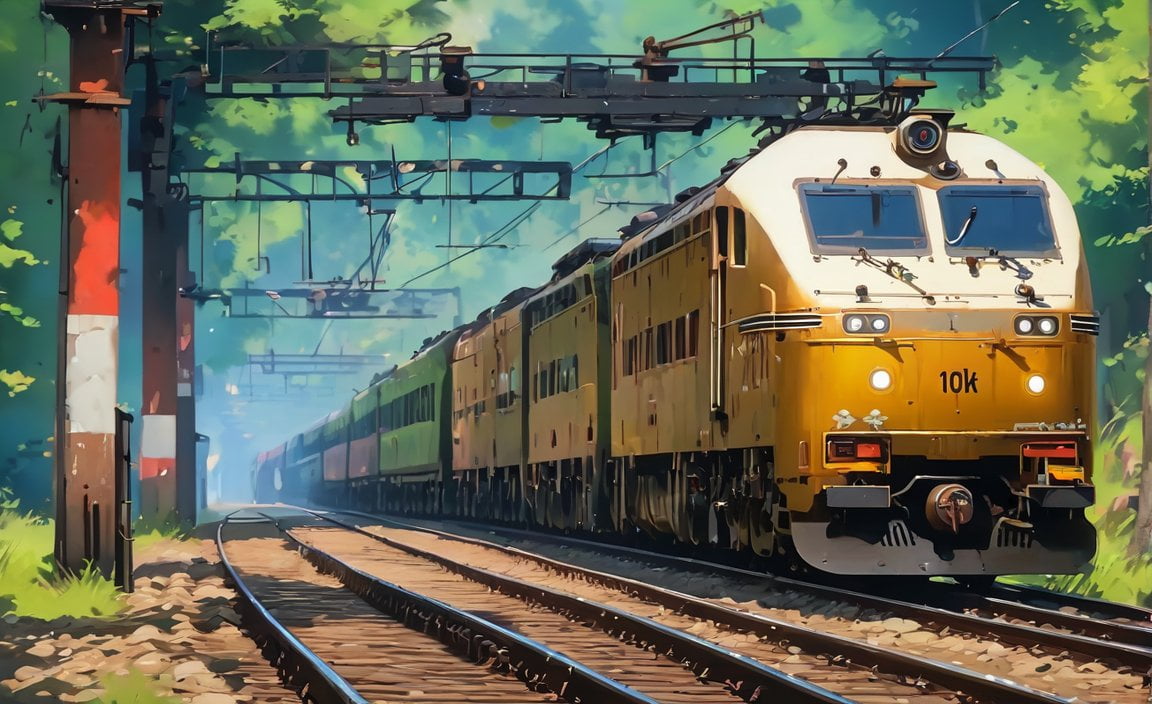Unveiling the Legacy: 10 Fascinating Railroad Facts
Embark on a journey through time and explore the captivating world of railroads, where monumental iron beasts once roared across vast landscapes, connecting cities and bridging gaps in human progress. In this article, we unveil 10 intriguing facts about railroads that will leave you in awe of their enduring legacy. From revolutionary technological advancements to transformative social and economic impacts, these facts offer a glimpse into the fascinating and dynamic realm of rail transportation. Join us as we delve into the untold stories and hidden intricacies that make railroads an indispensable part of our history and future.
Key Takeaways:
- The word “train” comes from a French verb meaning to draw or drag.
- Trains are considered one of the most eco-friendly modes of travel.
- The heaviest recorded train weighed a staggering 95,000 tonnes.
- The adoption of four time zones in the U.S. was facilitated by fast train travel across the continent.
- Railroads have lower frictional resistance than roads, allowing for longer trains.
- Ghost trains are a phenomenon found frequently on the British Train Network.
- The first Indian passenger train began operations on April 16th, 1853.
- The New Delhi Railway station has the world’s largest interlock system.
- The fastest train in the Indian Railways is the New Delhi-Bhopal Shatabdi Express, reaching speeds of 150 km/h.
- Railroads have a significant economic, social, and environmental impact, contributing to their enduring legacy.
10 Facts About Railroads

Railroads, with their rich history and significant impact on societies, provide a fascinating glimpse into the world of transportation. Whether you’re a railroad enthusiast or simply curious about the topic, here are 10 captivating facts that will unveil the enduring legacy of railroads:
1. The Origin of the Word “Train”:
Did you know that the word “train” comes from a French verb meaning to draw or drag? It perfectly captures the essence of this mode of transportation, as trains are indeed vehicles that are drawn or pulled by locomotives.
2. Eco-Friendliness of Trains:
In an era when environmental concerns are paramount, trains have positioned themselves as one of the most eco-friendly ways to travel. Compared to cars or planes, trains have a significantly lower carbon footprint, emitting fewer greenhouse gases and consuming less fuel per passenger mile.
3. The Weight Record Holder:
Imagine a train weighing a staggering 95,000 tonnes! Well, that’s exactly what the heaviest train ever recorded clocked in at. This mind-boggling weight showcases the impressive power and strength of rail transportation.
4. The Influence on Time Zones:
The adoption of time zones in the United States owes a debt of gratitude to railroads. Initially, the U.S. operated on numerous local times, but as trains enabled fast cross-country travel, coordinating schedules became a necessity. Consequently, the U.S. adopted four time zones, revolutionizing the way we perceive time.
5. Frictional Advantage of Railroads:
The smooth steel tracks offer a significant advantage over roads in terms of frictional resistance. The reduced friction allows trains to overcome the limitations faced by road vehicles, enabling longer and heavier trains to be operated. This efficiency in transportation has played a vital role in facilitating trade and economic development.
6. Ghost Trains of the British Rail Network:
Beware the eerie phenomenon of ghost trains that frequently traverse the British Rail Network. These mysterious trains, devoid of passengers, continue to run their routes even when no one is aboard. Their existence adds a touch of intrigue to the rich tapestry of railway history.
7. India’s Pioneering Passenger Train:
On April 16th, 1853, India witnessed an iconic moment in its transportation history. The first passenger train in India embarked on its inaugural journey, paving the way for the extensive railway network that now spans the country.
8. World’s Largest Interlock System:
Make your way to the New Delhi Railway Station in India, and you’ll find yourself in the presence of the world’s largest route of the interlock system. This intricate network of switches and signals ensures the safe and efficient movement of trains in the station, showcasing the engineering marvel behind railroad operations.
9. India’s Speedster:
Hop aboard the New Delhi-Bhopal Shatabdi Express in India, and you’ll experience high-speed rail travel at its finest. This train claims the title of being the fastest in the Indian Railways, zooming along at a breathtaking speed of 150 km/h (93 mph).
10. The Trans-Siberian Railway:
Spanning an impressive 9,289 kilometers (5,772 miles), the Trans-Siberian Railway is the epitome of an engineering marvel. Connecting Moscow with Vladivostok, this railway route cuts through diverse landscapes, providing a captivating journey through Russia’s vast wilderness and cultural tapestry.
Railroads boast a wealth of intriguing facts that shed light on their historical significance, environmental benefits, and incredible engineering achievements. With their enduring legacy, railroads continue to shape the world of transportation, leaving an indelible mark on societies worldwide. So, the next time you hear the distant rumble of a passing train, take a moment to appreciate these incredible machines and the stories they carry.
If you’re interested in exploring the breathtaking landmarks of Australia, you’ll definitely want to check out these 10 famous landmarks in Australia. From the iconic Sydney Opera House to the stunning Great Barrier Reef, this list will take you on an unforgettable journey through the Land Down Under. So go ahead and click here to discover the wonders of Australia: 10 famous landmarks in Australia.
French Guiana is not just a remote corner of South America – it’s a treasure trove of fascinating facts waiting to be explored. Get ready to be amazed by these 10 fun facts about French Guiana. Did you know that it’s home to the European Space Agency’s spaceport? Or that it’s the only region of South America where the Euro is used? If you’re curious to learn more, click here: 10 fun facts about French Guiana.
Prince Edward Island may be small in size, but it’s big on interesting facts. You won’t believe the unique history and natural wonders that await you on this enchanting island. From Anne of Green Gables to stunning red sand beaches, Prince Edward Island is a hidden gem in Canada. Don’t miss out on these 10 interesting facts about Prince Edward Island – click here to uncover the island’s secrets: 10 interesting facts about Prince Edward Island.
Technological Advancements in Railroads

The rail industry is on the cusp of an exciting era of innovation, driven by technological advancements that are shaping its future. From autonomous trains and the Internet of Trains to artificial intelligence (AI), decarbonization, rail connectivity, passenger experience, high-speed rail, and rail automation, these trends are revolutionizing the industry and propelling it forward.
Autonomous Trains: Punctuality, Reliability, and Capacity Optimization
Autonomous trains, enabled by advanced sensor technology and real-time data transmission, are one of the top trends in the rail industry. These trains operate automatically, improving punctuality, reliability, and capacity optimization. They can even test different levels of automation, such as GoA3 in regular passenger operation and GoA4 during shunting. By optimizing regional rail operations, reducing energy consumption, and increasing ride comfort, autonomous trains are transforming the way railways operate.
The Internet of Trains: Real-time Data Exchange and Analysis
The Internet of Trains refers to the interconnectedness of trains, infrastructure, and control systems. This connectivity enables real-time data exchange and analysis, leading to better decision-making, improved maintenance, and enhanced safety. By leveraging the power of connectivity, railways can make informed decisions, identify maintenance needs proactively, and ensure a safer and more efficient operation.
Artificial Intelligence (AI): Enhancing Safety, Reliability, and Customer Service
AI-powered systems are playing a crucial role in the rail industry by analyzing vast amounts of data collected by railroads. This enables improvements in safety, reliability, and customer service. Railways can use AI to enhance operations, optimize train schedules, predict maintenance needs, and provide a more personalized and efficient service to passengers. AI is a game-changer in making rail travel safer, more reliable, and more enjoyable.
Decarbonization: Reducing the Carbon Footprint
Decarbonization is a growing concern in the rail industry, and railroads are actively striving to reduce their environmental impact. By adopting cleaner and more sustainable technologies, such as electric or hydrogen-powered trains, the industry is taking steps towards a greener future. Additionally, eco-friendly practices are being implemented across the rail network to further contribute to the goal of reducing the carbon footprint.
Rail Connectivity: Seamless and Efficient Transportation Network
Railways are increasingly being connected to other modes of transportation, such as airports and ports, to create a seamless and efficient transportation network. This integration improves the overall passenger and freight experience and facilitates multimodal transportation. By making connections easier and smoother, rail connectivity enhances the efficiency and convenience of travel for both passengers and goods.
Enhanced Passenger Experience: Technology for Comfort and Convenience
Railroads are leveraging technology to enhance the passenger experience during their journeys. This includes offering Wi-Fi connectivity, digital ticketing systems, personalized travel recommendations, and onboard amenities. By providing these technological advancements, railroads are making travel more convenient, comfortable, and entertaining for passengers, ultimately improving their overall experience.
High-Speed Rail: Fast, Efficient, and Sustainable Transportation
High-speed rail is gaining prominence globally as many countries invest in high-speed rail networks. These networks aim to improve travel times, reduce congestion on roads and airports, and promote sustainable transportation options. High-speed rail offers a fast, efficient, and environmentally friendly mode of transportation for both passengers and goods, revolutionizing the way people travel.
Rail Automation: Improving Efficiency and Safety
Rail automation is another significant trend in the industry. By automating various aspects of rail operations, such as track maintenance, train control systems, and signaling, efficiency is improved, human errors are reduced, and safety is enhanced. Automation brings advancements to the rail industry, but it also poses challenges that need to be addressed, such as ensuring the safety and security of autonomous trains and interconnected systems.
The rail industry’s technological advancements are shaping the future of transportation. From autonomous trains and the Internet of Trains to AI, decarbonization, rail connectivity, enhanced passenger experience, high-speed rail, and rail automation, these trends are driving innovation and making rail travel safer, more efficient, and more sustainable.
Key Takeaways:
- Technological advancements in the rail industry are revolutionizing the way railways operate.
- Autonomous trains improve punctuality, reliability, and capacity optimization.
- The Internet of Trains enables real-time data exchange and analysis for better decision-making and enhanced safety.
- AI-powered systems enhance safety, reliability, and customer service in rail operations.
- Railroads are actively working towards decarbonization to reduce their environmental impact.
- Rail connectivity creates a seamless and efficient transportation network for passengers and goods.
- Technology is enhancing the passenger experience, providing comfort, convenience, and entertainment.
- High-speed rail offers a fast, efficient, and sustainable mode of transportation.
- Rail automation improves efficiency, reduces human errors, and enhances safety.
- Ensuring the safety and security of technological advancements is crucial in the rail industry.
Sources:
- AAR Blog – Technology Drives the Future of Rail
- StartUs Insights – Top 10 Rail Industry Trends in 2024
Economic Impact of Railroads
Railroads have played a significant role in shaping the economy, society, and history of the United States. From job creation to the facilitation of trade and economic development, the economic impact of railroads cannot be overstated. Here are 10 fascinating facts that highlight the enduring legacy of railroads:
Fact 1: Direct Economic Effects
According to the Economic and Fiscal Impact Analysis of Class I Railroads in 2017, direct economic effects are generated through operations and capital investment by Class I railroads. These effects include job creation and capital investment that support the operations of railroads, resulting in significant contributions to the economy^1^.
Fact 2: Job Creation and Economic Activity
Major U.S. railroads supported approximately 1.5 million jobs, nearly $274 billion in annual economic activity, approximately $88 billion in wages, and nearly $33 billion in tax revenues in 2014 alone^2^. These numbers highlight the substantial economic contribution of railroads to the nation.
Fact 3: Urbanization and Economic Prosperity
Railroads have had a profound impact on cities and urbanization. By the 1890s, railroads supplied cities and towns with essential resources such as food, fuel, building materials, and access to markets, leading to increased economic prosperity^3^. The economic growth of cities owes much to the development of railroads.
Fact 4: Revolutionizing Communication and Society
The construction of the Transcontinental Railway in the 1860s revolutionized communication and created a more interconnected society in the rapidly expanding United States^4^. Railroads played a crucial role in connecting people across vast distances while also facilitating the movement of goods, contributing to economic growth.
Fact 5: Facilitating International Trade
Railroads have facilitated international trade by enabling the transportation of Western food crops, raw materials, and manufactured goods between East and West Coasts^5^. This seamless transportation network has undoubtedly contributed to economic development and prosperity.
Fact 6: Improved Land Transport Efficiency
The development of railroads built upon transportation patterns that had existed for centuries, and the mounting of steam engines on railways greatly improved land transport efficiency^6^. Railroads provided a faster and more efficient mode of transportation, making trade and economic activities more accessible and viable.
These six facts illustrate the economic, social, and historical significance of railroads in the United States. Railroads have fostered job creation, economic activity, and efficient transportation, thereby shaping the nation’s development.
Key Takeaways:
- Railroads generate direct economic effects through operations and capital investment, contributing to job creation and economic activity^1^.
- Major U.S. railroads supported millions of jobs and contributed billions of dollars to the economy^2^.
- Railroads played a vital role in urbanization and economic prosperity^3^.
- The construction of the Transcontinental Railway revolutionized communication and society in the United States^4^.
- Railroads have facilitated international trade, enabling the transportation of goods across vast distances^5^.
- The mounting of steam engines on railways greatly improved land transport efficiency, supporting trade and economic development^6^.
Sources:
Environmental Impact of Railroads
Railroads have played a pivotal role in shaping transportation systems, fostering economic growth, and connecting communities. But what about their environmental impact? In this article, we’ll explore the lesser-known facts about the environmental impact of railroads that highlight their sustainability and significance in today’s world.
Fact 1: Railroads are a low-emission mode of transportation
When it comes to reducing greenhouse gas emissions, railroads are leading the way. Compared to other freight transportation modes like trucking, rail emits significantly less CO2. In fact, railroads emit only 23 grams of CO2 per ton-mile while trucks emit a whopping 202 grams of CO2 per ton-mile[^3^]. This stark contrast highlights rail’s sustainability advantage in reducing carbon footprints.
Fact 2: Railroads are investing in environmental conservation initiatives
Railroads are committed to protecting the environment. They actively invest in environmental efforts such as remediation projects, tree planting, and conservation initiatives to ensure the preservation of natural resources and ecosystems[^4^]. These proactive measures demonstrate their dedication to sustainable practices and environmental stewardship.
Fact 3: Rail infrastructure faces climate change risks
Climate change poses significant risks to rail infrastructure worldwide. Rising temperatures and extreme weather events threaten the stability and safety of tracks and overhead wires[^2^]. As a result, railroads have implemented various adaptations, such as replacing wooden infrastructure, raising tracks to avoid flooding, and adjusting maintenance projects to reduce track-buckling[^5^]. These measures ensure the resilience and longevity of rail systems in the face of climate challenges.
Fact 4: Railroads contribute to reducing congestion and air pollution
By transporting large volumes of goods and passengers, railroads play a crucial role in reducing congestion on roads and highways. By diverting freight and travelers to rail, fewer vehicles on the road mean reduced traffic congestion and lower air pollution levels. This not only improves air quality but also enhances the overall quality of life in urban areas.
Fact 5: Railroads enable efficient energy use
The energy efficiency of rail transportation is remarkable. Trains consume significantly less fuel per ton-mile compared to other modes of transportation like cars and planes[^2^]. This efficiency is further enhanced when railroads adopt clean and sustainable technologies, such as electric or hydrogen-powered trains. By optimizing energy consumption, railroads contribute to a more sustainable future.
Fact 6: Railways support a shift towards sustainable freight transportation
As the world seeks to transition to a low-carbon economy, railroads offer a viable solution for sustainable freight transportation. By transporting goods in large quantities, rail reduces the need for multiple trucks, resulting in fewer emissions and lower fuel consumption[^3^]. This shift to rail not only benefits the environment but also helps businesses achieve their sustainability goals and reduce logistics costs.
Fact 7: Railroads provide efficient intermodal transportation
Intermodal transportation, combining different transportation modes, is key to achieving a sustainable and efficient logistics network. Railroads play a vital role in intermodal transportation by facilitating seamless connections between different modes, such as rail to air, rail to sea, or rail to truck. This integration reduces the reliance on less sustainable modes and promotes a greener and more efficient supply chain.
Fact 8: Railroads contribute to a circular economy
In a circular economy, resources are reused and waste is minimized. Railroads actively contribute to this concept by enabling the transportation of materials for recycling and waste management. By facilitating the movement of goods crucial to the circular economy, railroads support sustainable practices that minimize waste and conserve resources.
Fact 9: Railroads are at the forefront of technological advancements
Innovation and technology are driving the future of railroads. From the adoption of autonomous trains enabled by advanced sensors to the implementation of artificial intelligence for improved operations and safety, railroads are embracing cutting-edge technologies to reduce environmental impact while enhancing efficiency[^1^]. These advancements highlight the industry’s commitment to continual improvement and sustainability.
Fact 10: Railroads contribute to a sustainable future
Railroads have a significant role to play in achieving a sustainable future. By reducing emissions, supporting clean energy adoption, and providing efficient transportation solutions, railroads contribute to a more environmentally friendly and resilient transportation system. Their commitment to sustainability demonstrates their intent to leave a positive legacy for future generations.
Key Takeaways:
- Railroads emit significantly less CO2 per ton-mile compared to trucking, making them a low-emission mode of transportation[^3^].
- Railroads invest in environmental conservation initiatives, including remediation projects and tree planting[^4^].
- Climate change poses risks to rail infrastructure, but railroads implement adaptations to mitigate these challenges, such as raising tracks and replacing wooden infrastructure[^2^][^5^].
- Railroads reduce congestion and air pollution by diverting goods and passengers from road transportation[^2^].
- Trains are highly energy-efficient, consuming less fuel per ton-mile compared to other transportation modes[^2^].
- Railroads support the shift towards sustainable freight transportation by transporting goods in large quantities and reducing emissions[^3^].
- Railroads enable efficient intermodal transportation, seamlessly connecting different modes and reducing reliance on less sustainable options[^2^].
- Railroads contribute to a circular economy by facilitating the movement of materials for recycling and waste management.
- Railroads embrace technological advancements such as autonomous trains and artificial intelligence to reduce environmental impact and enhance efficiency[^1^].
- Railroads play a crucial role in building a sustainable future through their commitment to minimizing emissions and providing efficient transportation solutions.
[^1^]: AAR Blog – Technology Drives the Future of Rail
[^2^]: StartUs Insights – Top 10 Rail Industry Trends in 2024
[^3^]: FreightWaves – 5 Rail Sustainability Trends for 2021
[^4^]: Inside Climate News – Climate Change Threatens Railroads That Already Are Short of Funds
[^5^]: Federal Railroad Administration – Rail Climate Considerations
FAQ
Q1: How did the word “train” originate?
A1: The word “train” comes from a French verb meaning to draw or drag. [^1^]
Q2: Are trains an eco-friendly mode of transportation?
A2: Yes, trains are one of the most eco-friendly ways to travel. [^1^]
Q3: What is the heaviest train ever recorded?
A3: The heaviest train ever recorded weighed 95,000 tonnes. [^1^]
Q4: How did trains influence the adoption of time zones in the United States?
A4: The United States adopted four time zones only after trains enabled fast travel across the continent. [^1^]
Q5: What is the advantage of railroads in terms of frictional resistance?
A5: Railroads have lower frictional resistance compared to roads, allowing for longer trains. [^3^]









